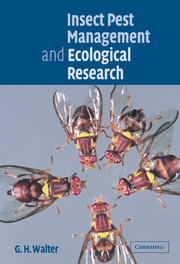Book contents
- Frontmatter
- Contents
- Preface
- Acknowledgements
- 1 Introduction
- Part 1 The place and nature of insect ecology research for IPM
- Part 2 Specific directions in insect ecology research for IPM
- 6 Understanding species: good taxonomy, sexual species and pest management
- 7 Polyphagous pests, parasitoids and predators: trophic relations, ecology and management implications
- 8 Pre-release evaluation and selection of natural enemies: population and community criteria
- 9 Autecological research on pests and natural enemies
- Part 3 Synopsis: Ecological research for IPM today
- References
- Index
9 - Autecological research on pests and natural enemies
Published online by Cambridge University Press: 22 August 2009
- Frontmatter
- Contents
- Preface
- Acknowledgements
- 1 Introduction
- Part 1 The place and nature of insect ecology research for IPM
- Part 2 Specific directions in insect ecology research for IPM
- 6 Understanding species: good taxonomy, sexual species and pest management
- 7 Polyphagous pests, parasitoids and predators: trophic relations, ecology and management implications
- 8 Pre-release evaluation and selection of natural enemies: population and community criteria
- 9 Autecological research on pests and natural enemies
- Part 3 Synopsis: Ecological research for IPM today
- References
- Index
Summary
[T]here should be applicable ecological theory to help choose natural enemies, plan their release, and perhaps alter the agroecosystem.
w. w. murdoch & c. j. briggs (1996, p. 2001)Introduction
The point made by Murdoch and Briggs in the text above is of central importance to improving pest management practice in general and biocontrol in particular. The difficulty lies in deciding upon the appropriate direction to take in seeking that theory (Chapters 4–6). Demographic theory in ecology currently holds a monopoly in attempts to understand the ecology of pests and natural enemies (Chapters 5–7) and to apply theory to biocontrol practice (Chapter 8). Autecology has seldom been mentioned as an alternative source of theory and insight. A problem for autecology is its frequent misrepresentation as simple natural history observation. Even when natural history observation has been mentioned as useful, it has been portrayed as intuitive observation whose utility is to fill in gaps of fact.
This chapter therefore examines how a changed perception of autecology can provide a scientifically sound and helpful theoretical basis for enhancing biocontrol theory and practice. Autecology is based on the integration of physiological, behavioural and ecological principles into an evolutionary framework that is consistent with such principles and which has its basis in the recognition concept of species (see Chapter 6). Natural selection provides a common basis for these principles, but is not seen as an agent of optimisation. Natural selection acts directly on the mechanisms, not their postulated efficiency within a competitively driven world.
- Type
- Chapter
- Information
- Insect Pest Management and Ecological Research , pp. 235 - 270Publisher: Cambridge University PressPrint publication year: 2003
- 1
- Cited by



